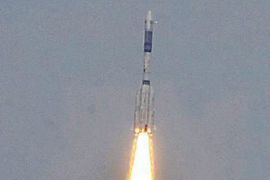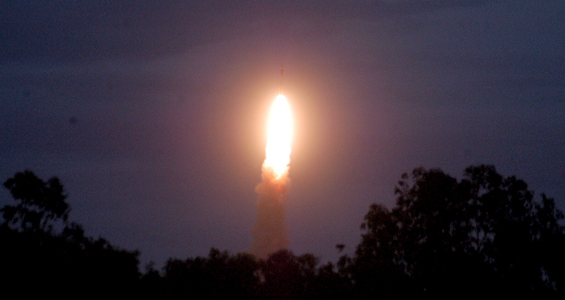India’s bid to beat tech sanctions
Attempted rocket launch after years of sanctions holds lessons for US and Iran.

 |
| Thursday’s blast-off will mark India’s entry into the satellite launcher market on a fully indigenous rocket [EPA] |
As India’s indigenous cryogenic engine ignites on Thursday to thrust a 416-tonne rocket into space, it will also be punching a big hole in the theory of sanctions.
The launch comes at a pivotal time when efforts to impose sanctions on Iran because of its nuclear programme are gaining momentum ahead of next month’s UN conference that will seek to reinforce provisions of the nuclear Non-Proliferation Treaty.
If a case is to be made against the current sanctions move, nothing could be more effective than this rocket launch. It should be a wake-up call for the proponents of sanctions, if any was needed at all.
Proving the premise wrong would be the liquid cryogenic engines of the Geo-Synchronous Satellite Launch Vehicle (GSLV) that India was forced to develop on its own when slapped with Western-inspired sanctions in 1998 when it carried out nuclear tests.
India’s quest for a cryogenic engine had begun much earlier in 1993 and the sanctions hampered its initiatives very badly.
Hampered initiatives
|
“For the first time we are testing the cryogenic engine and stage in the flight. It has to perform well. Only when we achieve it then I can say, India has done it, the sixth country in the world to have this complex cryogenic engine technology” Dr K Radhakrishnan, chairman, Indian Space Research Organisation (ISRO) |
As in the case with Iran and its nuclear ambitions, Russia was helping India build the engine and the initial contract involved transfer of technology.
Russia was forced to stop the transfer under pressure from the United States under the aegis of the Missile Technology Control Regime that was put in place to ostensibly prevent the proliferation of unmanned systems capable of delivering weapons of mass destruction.
The argument given then was that India would use these engines to make missiles. Exactly the same stick is being used to beat the Iranians without much credible evidence.
That none of the missiles India developed since then use cryogenic engines dilutes the argument.
It only lends credence to what many in India’s space establishment believe was the real reason behind withholding technology. They say it was not “global security” but big commerce that was behind the move.
These engines are required to launch the geo-synchronous satellites that are used in communications.
Lucrative business
It is a lucrative business. The US, Russia, China, France and Japan are the only countries that have the technology for these engines and they are not very keen to lose their commercial advantage.
Emergence of India as a low-cost satellite launcher would inevitably eat into their share of the pie.
Undaunted by the hurdles placed in their path, hundreds of Indian scientists toiled to master cryogenic technology at the Liquid Propulsion System Centre at Mahendragiri in the southern state of Tamil Nadu.
The work there involved materials working at minus 250 degree and pumps at speeds of 40,000 rpm. Complex metering, monitoring and integrating technologies were also involved.
The engines are required to fire for about 700 seconds during the final stage of a launch providing seven tonnes of thrust.
First signs of success came on February 10, 2002 when India tested an engine for the first time.
It ran for a few seconds. Eight months later, on September 14, 2002 the engine was run for 1000 seconds. This confirmed that the design was sound. On March 12, 2003 the engine was ready for manufacture.
Fully indigenous
On that day, Atal Bihari Vajpayee, the then Indian prime minister, made a terse remark in parliament: “We have been able to successfully develop the cryogenic engine on our own”.
 |
| US, Russia, China, France and Japan are the other nations with cryogenic engines [EPA] |
In the meantime, despite the sanctions, India kept its GSLV programme on course with cryogenic engines sourced from Russia.
It entered the exclusive GSLV launchers’ club on April 18, 2001 when it successfully launched a 1.5 tonne satellite and parked it 36,000km above in sync with the earth’s rotation.
Four other such launches have followed since then.
What is significant about Thursday’s attempt is that it will mark India’s entry into the launcher market on a fully home-grown rocket.
“For the first time we are testing the cryogenic engine and stage in the flight. It has to perform well. Only when we achieve it then I can say, India has done it, the sixth country in the world to have this complex cryogenic engine technology,” Dr K Radhakrishnan, chairman, Indian Space Research Organisation (ISRO), said prior to the launch.
It would also showcase that within a decade India overcame sanctions to internalise and commercialise an advanced technology.
A display of prowess the Iranians would sure take heart from and sufficient to worry the United States.